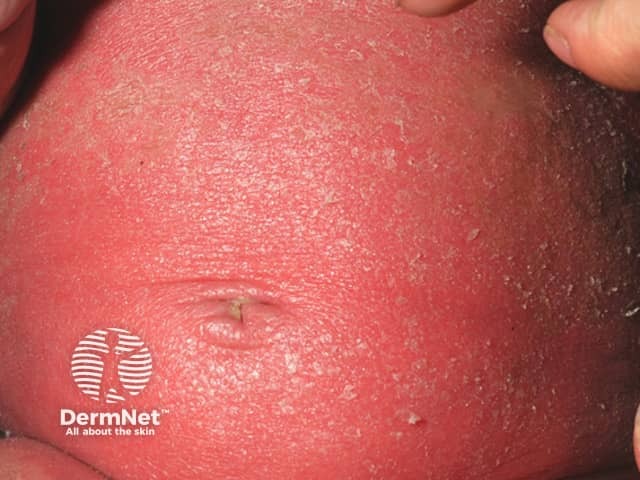Main menu
Common skin conditions

NEWS
Join DermNet PRO
Read more
Quick links
Author: Dr Scott Barker, Dermatology Registrar, Dept of Dermatology Waikato Hospital, Hamilton, New Zealand, 2004. Updated by Dr Arun Gangakhedkar, Paediatrician, Waitakere Hospital, Auckland, New Zealand. August 2018.
Introduction - biotin Introduction Clinical features Diagnosis Treatment Help with other skin conditions Laboratory testing
Biotin is an essential micronutrient. It is one of the B vitamins and is also known as Vitamin H – ‘H’ stands for ‘haut’, the German word for skin. It is also marketed as vitamin B7 and coenzyme R.
Biotin is found in many foods and is made by bacteria, fungi, algae and certain plant species. There are particularly high amounts of biotin in brewer's yeast and in Royal Jelly. Foods containing the vitamin include liver, egg yolks, fish, meat, seeds, nuts, and vegetables.
Human tissues do not make biotin, although it is made by the bacteria that live in the large intestine.
Biotin acts as a cofactor for the function of carboxylase synthetase enzymes. Carboxylases are enzymes that catalyse the addition of a molecule of carbon dioxide to another compound to form a carboxyl group. The carboxylases catalyse fatty acid biosynthesis, gluconeogenesis, tricarboxylic acid cycle and also play a role in gene regulation.
These are either acquired or inherited problems that resolve when extra biotin is taken.
Biotin deficiency can be acquired by:
There are three rare autosomal recessive inherited biotin responsive dermatoses, which may occur from inborn errors of multiple carboxylase deficiency (MCD).
Autosomal-recessive inheritance means two abnormal genes are required to cause disease, one coming from each parent. One-in-four of the parents' male and/or female children will be affected by the disease, but it is unlikely in other family members.
Holocarboxylase synthetase catalyzes the bonding of biotin to the carboxylases. Deficiency of holocarboxylase synthetase results in a greater requirement for biotin and multiple carboxylase deficiency. This results in an accumulation of organic acids in the urine.
Biotinidase secreted by the pancreas and intestines catalyzes the release of free biotin from biocytin and biotin-containing peptides and salvages biotin for reuse during cellular turnover. It is also needed to release bound ingested biotin for absorption. A shortage of the enzyme results in a greater requirement for the vitamin than normal. Several mutations are reported for biotinidase deficiency. Early manifestations in infancy are acidosis, seizures, hypotonia, developmental delay. The dermatological features are skin rash and alopecia, which are reversible with early initiation of treatment.
The inherited conditions causing biotin deficiency usually present in the first few weeks of life. The major features of biotin responsive dermatoses are rash and neurological problems.
Early manifestations in infancy are acidosis, seizures, hypotonia, and developmental delay. The dermatological features are skin rash and alopecia, which are reversible with early initiation of treatment. (MGM report 2015).
The seborrhoeic, periorificial and intertriginous distribution of rash is similar to dermatitis in zinc deficiency (see Acrodermatitis enteropathica-like conditions).
The non-specific erythematous scaly eruption is typically localised to moist and periorificial areas but may become generalised to resemble psoriasis, seborrhoeic dermatitis or ichthyosis.
Periorificial distribution is especially prominent around the eyes, nose, mouth, ears and genitals. Alopecia (hair loss) may be seen with sparse hair, thinning of eyebrows and eyelashes. Atrophy of lingual papillae (a smooth tongue) and blepharoconjunctivitis (red eyes) may be present.
The rash is red and scaly and sometimes there are erosions. It develops over most of the body and may resemble psoriasis, seborrhoeic dermatitis or ichthyosis. It is especially prominent around the eyes, nose, mouth, ears and genitals. Alopecia (hair loss) and conjunctivitis (red eyes) may be present.

Holocarboxylase synthetase deficiency

Holocarboxylase synthetase deficiency

Holocarboxylase synthetase deficiency
Progressive severe neurological symptoms develop in the untreated inherited conditions. These include seizures, developmental delay, poor feeding and death.
For adults with acquired biotin deficiency, the rash is similar but neurological symptoms include hyperaesthesia (sensitive skin), paraesthesia (pins and needles), depression and muscle pain.
Holocarboxylase synthetase deficiency and biotinidase deficiency are diagnosed in the neonatal and infant period respectively by finding high levels of organic acids in urine. Blood tests can then be done on white cells and plasma to measure enzyme levels to confirm the diagnosis. A newborn metabolic screen may detect the inherited enzyme deficiencies.
Acquired biotin deficiency is diagnosed on clinical grounds and response to treatment.
A trial of biotin should be given in those with suspected or confirmed biotin deficiency. Usually, a dose of 10–20 mg per day will be adequate. Biotinidase deficiency usually responds rapidly and dramatically to as little as 10 mg per day. The cutaneous eruption typically resolves within weeks of biotin replacement, and hair regrowth occurs from weeks to months on treatment.
Holocarboxylase synthetase deficiency may require much larger doses. There are reports of poor response even to 200 mg/day.
There are unconfirmed reports that biotin supplements may also be helpful for a rare congenital hair disorder called the ‘uncombable hair syndrome', also known as ‘spun-glass hair’ and ‘cheveux incoiffables’. Although it has been added to many cosmetic hair products, it is uncertain whether it is of any benefit for those with normal hair.
Biotin 300 micrograms daily may also be useful for thin, brittle fingernails and those with lamellar splitting, but this is unconfirmed.
Biotin may be useful in at least some cases of Leiner disease.
In general, healthy people consuming a normal diet do not require supplementation with biotin for their skin, hair or nails.
The daily recommended intake for a healthy adult is 30 micrograms (µg), but many multivitamin and biotin supplements contain much higher doses, ranging from 5,000 µg (5 mg) to 10,000 µg (10 mg). Supplements can interfere with the results of common immunoassay blood tests that use biotin technology, particularly thyroid function tests. Inaccurate test results could result in overtreatment, undertreatment and even death of the patient.
If test results are not those expected clinically, the biotin-containing supplement should be discontinued for 3 days before repeating the tests.